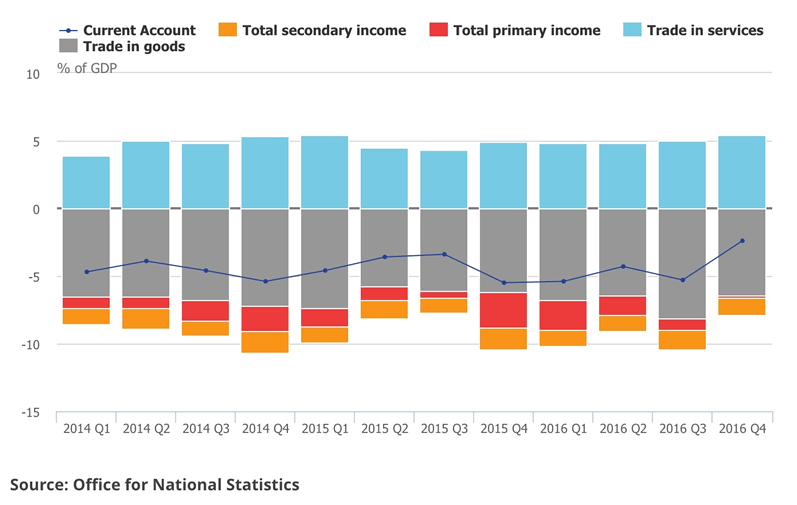UK Current Account Deficit Falls to Lowest Level in Years as UK Exports Rise
The UK's current account deficit - that millstone that hangs around the Pound’s neck - fell sharply in the final quarter of 2016 it has been revealed.
The news will take economists by surprise as it suggests the UK’s overall trade position with the rest of the world has improved markedly and it would appear the devaluation of the Pound following the EU referendum in June has played no small part.
The latest Balance of Payments data from the ONS, released at 09:30 on Friday, March 31, show that the UK’s current account deficit was £12.1 billion in Quarter 4.
This represents a narrowing of £13.6 billion from a revised deficit of £25.7 billion in Quarter 3 2016.

The improvement comes thanks to a sharp narrowing in the deficit on Trade; the deficit in Quarter 4 equated to 2.4% of gross domestic product (GDP) at current market prices, down from 5.3% in Quarter 3.
Foreign exchange analysts have long pointed to the current account deficit as being the reason why Sterling must fall as the UK relies on foreign investor inflows to balance out the deficit created by the country’s reliance on imports.
But, should this gap close, then Sterling would arguably have a firmer platform to stand on.
However, we are told the improvement is not enough to protect Sterling from further potential weakness.
"Overall, the numbers suggest the current account may improve if global yields continue to head higher, but not by enough if the goods balance does not improve back to pre-2016 levels which would require a weak, or even weaker, GBP," warns Jordan Rochester at Nomura in London.
Trade Deficit Narrows
The ONS reports the total trade deficit narrowed to £4.8 billion in Quarter 4 2016, following a sharp widening of the deficit in Quarter 3 2016 (£14.8 billion).
This narrowing was predominantly due to an increase in the exports of goods of £7.6 billion.
This suggests that the fall in value of Sterling has allowed exporters to ramp up business.
A cheaper Pound makes UK goods cheaper on the global market place and there were concerns that the impact was not actually being reflected in export books.
But the official data suggests otherwise.
"The improvement in the goods balance suggests the “J-curve” impact of GBP’s devaluation is taking place (after an £8.4bn decline in Q3). We’ll have to wait to see if this is the start of a new trend," says Rochester.
The 'J curve' refers to the trend of a country’s trade balance following a devaluation or depreciation under a certain set of assumptions.
A devalued currency means imports are more expensive, and on the assumption that the volume of imports and exports change little immediately, this causes a depreciation of the current account (a bigger deficit or smaller surplus).
"After some time, though, the volume of exports may start to rise because of their lower more competitive prices to foreign buyers, and domestic consumers may buy fewer of the costlier imports. Eventually, if this happens, the trade balance should improve on what it was before the devaluation," explants Robert Feenstra in his book International Macroeconomics.
Primary Income Deficit Narrows
The primary income deficit narrowed from £4.3 billion in Quarter 3 2016 to a three year low of £1.0 billion in Quarter 4 2016.
The primary income is that flow of capital that comes to the UK from the foreign investments held by UK-domiciled companies and individuals.
And for you Brexiteers out there it is confirmed that we still import a huge amount from Europe as the ONS reports a current account deficit of £19.5 billion with the EU in Quarter 4 2016 whilst a surplus of £7.4 billion was recorded with non-EU countries.



